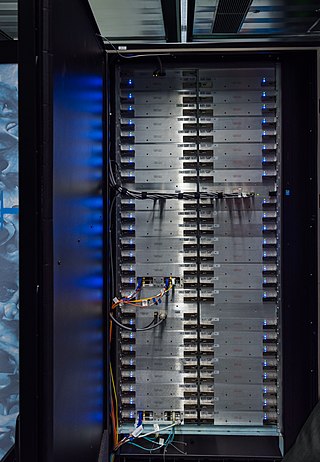
A supercomputer is a type of computer with a high level of performance as compared to a general-purpose computer. The performance of a supercomputer is commonly measured in floating-point operations per second (FLOPS) instead of million instructions per second (MIPS). Since 2017, supercomputers have existed which can perform over 1017 FLOPS (a hundred quadrillion FLOPS, 100 petaFLOPS or 100 PFLOPS). For comparison, a desktop computer has performance in the range of hundreds of gigaFLOPS (1011) to tens of teraFLOPS (1013). Since November 2017, all of the world's fastest 500 supercomputers run on Linux-based operating systems. Additional research is being conducted in the United States, the European Union, Taiwan, Japan, and China to build faster, more powerful and technologically superior exascale supercomputers.
Floating point operations per second is a measure of computer performance in computing, useful in fields of scientific computations that require floating-point calculations.
Cray Inc., a subsidiary of Hewlett Packard Enterprise, is an American supercomputer manufacturer headquartered in Seattle, Washington. It also manufactures systems for data storage and analytics. Several Cray supercomputer systems are listed in the TOP500, which ranks the most powerful supercomputers in the world.

David A. Bader is a Distinguished Professor and Director of the Institute for Data Science at the New Jersey Institute of Technology. Previously, he served as the Chair of the Georgia Institute of Technology School of Computational Science & Engineering, where he was also a founding professor, and the executive director of High-Performance Computing at the Georgia Tech College of Computing. In 2007, he was named the first director of the Sony Toshiba IBM Center of Competence for the Cell Processor at Georgia Tech.

The President's Council of Advisors on Science and Technology (PCAST) is a council, chartered in each administration with a broad mandate to advise the president of the United States on science and technology. The current PCAST was established by Executive Order 13226 on September 30, 2001, by George W. Bush, was re-chartered by Barack Obama's April 21, 2010, Executive Order 13539, by Donald Trump's October 22, 2019, Executive Order 13895, and by Joe Biden's February 1, 2021, Executive Order 14007.
Wen-mei Hwu is the Walter J. Sanders III-AMD Endowed Chair professor in Electrical and Computer Engineering in the Coordinated Science Laboratory at the University of Illinois at Urbana-Champaign. His research is on compiler design, computer architecture, computer microarchitecture, and parallel processing. He is a principal investigator for the petascale Blue Waters supercomputer, is co-director of the Universal Parallel Computing Research Center (UPCRC), and is principal investigator for the first NVIDIA CUDA Center of Excellence at UIUC. At the Illinois Coordinated Science Lab, Hwu leads the IMPACT Research Group and is director of the OpenIMPACT project – which has delivered new compiler and computer architecture technologies to the computer industry since 1987. From 1997 to 1999, Hwu served as the chairman of the Computer Engineering Program at Illinois. Since 2009, Hwu has served as chief technology officer at MulticoreWare Inc., leading the development of compiler tools for heterogeneous platforms. The OpenCL compilers developed by his team at MulticoreWare are based on the LLVM framework and have been deployed by leading semiconductor companies. In 2020, Hwu retired after serving 33 years in University of Illinois at Urbana-Champaign. Currently, Hwu is a Senior Distinguished Research Scientist at Nvidia Research and Emeritus Professor at University of Illinois at Urbana-Champaign.
The National Center for Computational Sciences (NCCS) is a United States Department of Energy (DOE) Leadership Computing Facility that houses the Oak Ridge Leadership Computing Facility (OLCF), a DOE Office of Science User Facility charged with helping researchers solve challenging scientific problems of global interest with a combination of leading high-performance computing (HPC) resources and international expertise in scientific computing.

Jaguar or OLCF-2 was a petascale supercomputer built by Cray at Oak Ridge National Laboratory (ORNL) in Oak Ridge, Tennessee. The massively parallel Jaguar had a peak performance of just over 1,750 teraFLOPS. It had 224,256 x86-based AMD Opteron processor cores, and operated with a version of Linux called the Cray Linux Environment. Jaguar was a Cray XT5 system, a development from the Cray XT4 supercomputer.

Tianhe-I, Tianhe-1, or TH-1 is a supercomputer capable of an Rmax of 2.5 peta FLOPS. Located at the National Supercomputing Center of Tianjin, China, it was the fastest computer in the world from October 2010 to June 2011 and was one of the few petascale supercomputers in the world.
The Seymour Cray Computer Engineering Award, also known as the Seymour Cray Award, is an award given by the IEEE Computer Society, to recognize significant and innovative contributions in the field of high-performance computing. The award honors scientists who exhibit the creativity demonstrated by Seymour Cray, founder of Cray Research, Inc., and an early pioneer of supercomputing. Cray was an American electrical engineer and supercomputer architect who designed a series of computers that were the fastest in the world for decades, and founded Cray Research which built many of these machines. Called "the father of supercomputing," Cray has been credited with creating the supercomputer industry. He played a key role in the invention and design of the UNIVAC 1103, a landmark high-speed computer and the first computer available for commercial use.

Approaches to supercomputer architecture have taken dramatic turns since the earliest systems were introduced in the 1960s. Early supercomputer architectures pioneered by Seymour Cray relied on compact innovative designs and local parallelism to achieve superior computational peak performance. However, in time the demand for increased computational power ushered in the age of massively parallel systems.

Titan or OLCF-3 was a supercomputer built by Cray at Oak Ridge National Laboratory for use in a variety of science projects. Titan was an upgrade of Jaguar, a previous supercomputer at Oak Ridge, that uses graphics processing units (GPUs) in addition to conventional central processing units (CPUs). Titan was the first such hybrid to perform over 10 petaFLOPS. The upgrade began in October 2011, commenced stability testing in October 2012 and it became available to researchers in early 2013. The initial cost of the upgrade was US$60 million, funded primarily by the United States Department of Energy.
Steve Scott is a computer architect who currently serves as Corporate Vice President at Microsoft. Scott was previously a Senior Vice President and Chief Technology Officer at Cray Inc., Principal Engineer at Google and the chief technology officer for Nvidia's Tesla business unit. Scott was employed by Cray Research, Inc., Silicon Graphics, Inc., and Cray, Inc. from 1992 to 2011.

The high performance supercomputing program started in mid-to-late 1980s in Pakistan. Supercomputing is a recent area of Computer science in which Pakistan has made progress, driven in part by the growth of the information technology age in the country. Developing on the ingenious supercomputer program started in 1980s when the deployment of the Cray supercomputers was initially denied.
XK7 is a supercomputing platform, produced by Cray, launched on October 29, 2012. XK7 is the second platform from Cray to use a combination of central processing units ("CPUs") and graphical processing units ("GPUs") for computing; the hybrid architecture requires a different approach to programming to that of CPU-only supercomputers. Laboratories that host XK7 machines host workshops to train researchers in the new programming languages needed for XK7 machines. The platform is used in Titan, the world's second fastest supercomputer in the November 2013 list as ranked by the TOP500 organization. Other customers include the Swiss National Supercomputing Centre which has a 272 node machine and Blue Waters has a machine that has Cray XE6 and XK7 nodes that performs at approximately 1 petaFLOPS (1015 floating-point operations per second).

NVLink is a wire-based serial multi-lane near-range communications link developed by Nvidia. Unlike PCI Express, a device can consist of multiple NVLinks, and devices use mesh networking to communicate instead of a central hub. The protocol was first announced in March 2014 and uses a proprietary high-speed signaling interconnect (NVHS).

The Cray XC40 is a massively parallel multiprocessor supercomputer manufactured by Cray. It consists of Intel Haswell Xeon processors, with optional Nvidia Tesla or Intel Xeon Phi accelerators, connected together by Cray's proprietary "Aries" interconnect, stored in air-cooled or liquid-cooled cabinets. The XC series supercomputers are available with the Cray DataWarp applications I/O accelerator technology.
An AI accelerator, deep learning processor, or neural processing unit (NPU) is a class of specialized hardware accelerator or computer system designed to accelerate artificial intelligence and machine learning applications, including artificial neural networks and machine vision. Typical applications include algorithms for robotics, Internet of Things, and other data-intensive or sensor-driven tasks. They are often manycore designs and generally focus on low-precision arithmetic, novel dataflow architectures or in-memory computing capability. As of 2024, a typical AI integrated circuit chip contains tens of billions of MOSFETs.

Hewlett Packard Enterprise Frontier, or OLCF-5, is the world's first exascale supercomputer. It is hosted at the Oak Ridge Leadership Computing Facility (OLCF) in Tennessee, United States and became operational in 2022. As of December 2023, Frontier is the world's fastest supercomputer. It is based on the Cray EX and is the successor to Summit (OLCF-4). Frontier achieved an Rmax of 1.102 exaFLOPS, which is 1.102 quintillion floating-point operations per second, using AMD CPUs and GPUs.

Keren Bergman is an American electrical engineer who is the Charles Batchelor Professor at Columbia University. She also serves as the director of the Lightwave Research Laboratory, a silicon photonics research group at Columbia University. Her research focuses on nano-photonics and particularly optical interconnects for low power, high bandwidth computing applications.












